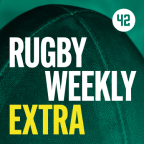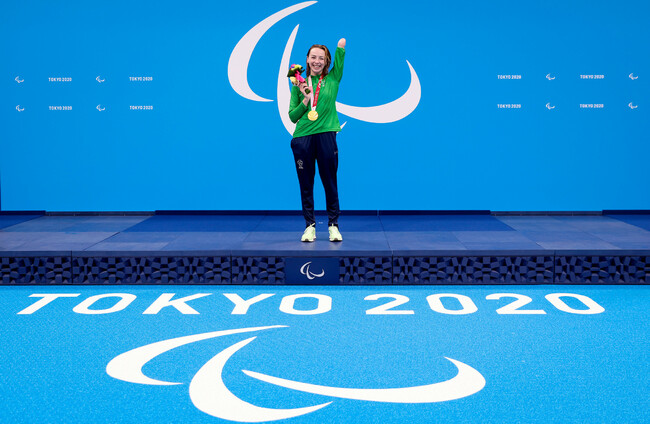ELLEN KEANE WENT to bed last night with a smile on her face and a gold medal under her pillow.
“So I knew where it was,” she explains with a laugh.
The Irish Paralympian swam to a stunning first place in the SB8 100m breaststroke on Thursday, edging out New Zealand’s most successful Paralympian Sophie Pascoe in a dramatic head-to-head battle.
It was a titanic performance that took a huge toll. Top of the podium proved the payoff, an aching body was the cost.
“I am so tired. It was so rushed yesterday,” the 26-year old says from Tokyo.
“After you swim a race, you need to swim down, You need to get all of that lactic acid out of your body and recover but I didn’t get that yesterday because it was (straight to) media. It was doping control. It was a medal ceremony. I didn’t even get a chance.
“This morning when I woke up I was in bits. ‘I can’t even think about the gold medal right now I am in so much pain.’ I just did a swim and I am starting to feel a little bit better.
“I am beginning to realise what I have done. It is really lovely to know I have actually, finally done it.”
The scale of her achievement is best illustrated by the storied trek that led to this summit. The event in Japan’s captial is Keane’s fourth Paralympics and her second medal after bronze in Brazil, but gold was also the goal. One of the first things her coach Dave Malone said to her post-race was “only took you 13 years!”
A dream delivered in style. The triumph came thanks to a personal best. 1:19.93, 1.78 seconds faster than her heat time which was also a PB.
She has developed to become an elite athlete and her sphere has developed simultaneously. This week it all collided in perfect harmony.
“The past 13 years have been amazing. In Beijing, there wasn’t that much coverage or knowledge about the Paralympics. They were still getting called the Special Olympics.
“Then in London 2012, with the coverage that Channel 4 did, people were starting to understand Paralympics a bit more. With Rio, having won the medal, it has always been growing but I feel like Toyko has been the pinnacle.
“This Games is the first Games I have been at where I have seen the Olympic logo and the Paralympic logo side by side. We are seen as equals here,” she stresses, before picking up an object from the desk in front of her.
“Even here is a bottle of water. It has the Paralympic and Olympic logo on it. I have never seen that before.
“In Rio, all the Olympic athletes got their phones and Paralympians didn’t get anything. Now here in Tokyo, we are getting all the same things. Being treated as equal Olympians. We are just athletes who happen to have a disability.
“The Japanese people really respect that. I am hoping that will go out through the rest of the world and start to seep into mainstream media. Start to see more people in mainstream media with disabilities. That is the goal of the Paralympics.”
Closer to home, Keane is hoping to inspire similar seismic change.
“In terms of inspiring people, I think the really special thing about the medals being won by Team Ireland is showing the country we’ve had a really, really rough 18 months. A lot of people aren’t able to do what they love.
“A lot of young athletes, age group athletes are out of their sport. They haven’t been able to train. They haven’t been able to see their friends. They might not even want to go back to sport once these activities start back up. We are here to show them what is possible.
“We are here to show them it is worth it, stick with your sport. Come back, you are capable of doing this. That is what all of us want to inspire, the younger generation to get back into sport. I hope that is what we are doing.”
In the build-up to Tokyo, the Clontarf swimmer opted to come off social media. It is something she feels had a significant benefit and an alteration she will adopt once again this week. After a day or two of enjoying the countless well wishes and celebrations, the phone will be put aside and focus will move to the 200m medley on September 1.
It is one of several changes she adopted for the final. Even after the heat, Keane concentrated on three things that needed some tinkering.
“I did a few things different. I watched my race back and I knew instantly what I needed to change. When I dove in the first thing I did wrong was I dropped my head. That is a habit I had from the past.
“I hadn’t been doing it recently. For some reason, I did it in my heat. That instantly created drag as soon as I dove in. that was the first thing I changed, I tried to keep my head more streamlined.
“My turn in my heat was awful. I knew it as soon as it happened. It was awful. I just misjudged how many strokes I needed to get to the wall. I ended up taking half a stroke and then one too many so for the final I focused on keeping my stroke a bit longer so I finished at the wall with a full stroke.
“For the heat swim, I didn’t have any coffee or anything beforehand. I had a little bit of caffeine to wake me up and get me going. Those were the three things I changed.”
No Twitter, better technique and a morning coffee. The winning formula.






